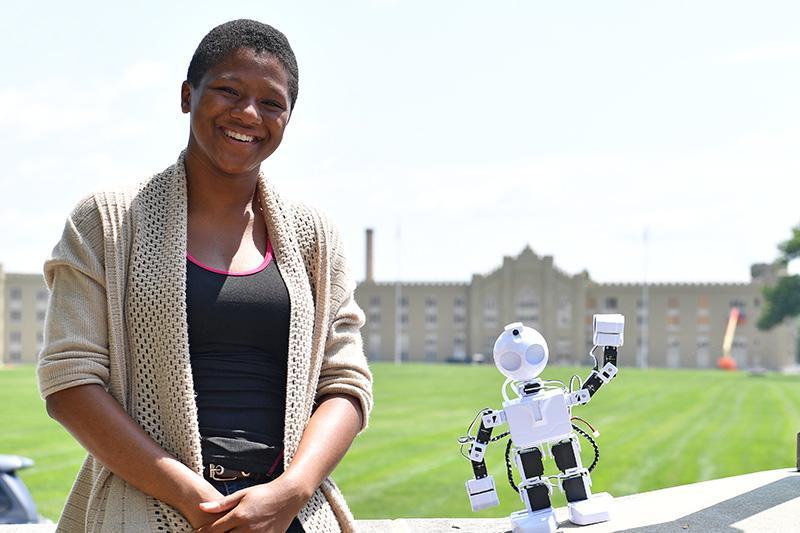BeanBot Research Bridges Psychology, Robotics

Miyah Boyd '20 pauses with her robot, JD, on the porch of Moody Hall.—VMI Photo by H. Lockwood McLaughlin.
LEXINGTON, Va., July 11, 2018—Miyah Boyd ’20 doesn’t aim low. This summer, she learned how to program a robot, but her goal is to provide an electronic companion for people with autism and social anxiety disorder so they can more smoothly navigate a world that they often perceive as harsh, chaotic, and threatening.
It’s a project spanning three disciplines: Boyd’s major, computer and information sciences, psychology, and electrical and computer engineering. In addition, Boyd is drawing from her own experience of loss after her 17-year-old sister died in a car accident six years ago.
“BeanBot,” as Boyd has christened her creation, will be a nonjudgmental friend to those in need of a little emotional support.
“BeanBot will be able to talk to them and sense when their heart rate is elevated,” Boyd explained. “It’s just a nice buddy that will help them with their day-to-day life.”
The name “BeanBot” came from Boyd’s roommate, Jennifer Hartman ’20. Hartman calls Boyd “Tink” because Boyd has metal in one of her hip joints after an operation last year, and in return, Boyd calls her close friend “Bean.”
The idea for BeanBot came about when Boyd took a class on the history of computers and technology taught by Maj. Hongbo Zhang, assistant professor of computer and information sciences. In that class, she was assigned to write a paper on a project she’d undertake using artificial intelligence.
At first, Boyd thought about creating a companion for those experiencing the loss of a loved one. The loved one’s voice could be programmed into a robot, she thought, enabling the mourner to have a final good-bye. Then she had second thoughts, realizing that many people would be unable to let go of a crutch such as this.
“I rerouted my idea to people with autism, social anxiety,” she stated. Boyd added that the robot should help people who normally wouldn’t open up to another human share their feelings more freely, as an inanimate object cannot judge them.
“It’s kind of a custom companion for people with disabilities,” said Dr. Ramoni Lasisi, assistant professor of computer and information science, who is guiding Boyd’s Summer Undergraduate Research Institute project.
The goal of Boyd’s summer research is to pave the way for BeanBot by learning how to program JD, a robot that Boyd built from a kit.
“[JD] teaches me how I should lay out his wiring and how everything should look,” said Boyd. “This summer has been me trying to design a prototype for BeanBot.”
The project will encompass the remainder of Boyd’s cadetship and culminate in a capstone project, which could be linked to capstone projects for cadets majoring in either psychology or electrical and computer engineering. Down the road, Boyd will decide on a format for BeanBot—a stand-alone robot, an app on a phone, or an app for the Apple watch or a similar device. So far, she’s leaning toward the watch.
“[Users] can carry it around and not bring unwanted attention,” she said.
After VMI, Boyd plans to commission into the Army National Guard and possibly work for the FBI. Inspired by the movie Hidden Figures, she’s also interested in working for NASA.
-Mary Price
-VMI-
.svg)
.png)